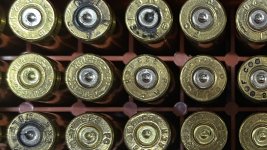You are using an out of date browser. It may not display this or other websites correctly.
You should upgrade or use an alternative browser.
You should upgrade or use an alternative browser.
.223 primer pocket telltales?
- Thread starter badmatrix
- Start date
Yes!The blackening is usually caused by gas leakage because the primer cup is not sealing properly against the pocket.
A common, but not the only possible cause is the primer pocket has expanded too much.
I noticed that. Why would the primers crack?Some of those primers cracked. The gas escaping will erode the bolt face.
I was going to ask if you know what brand those cracked primers are. Winchester had a problem for a while with their non-nickel-plated primers cracking and leaking because the brass cups were too thin, though they fixed that. I don't see any sign of excessive flattening on those cracked primers (nice rounded shoulder), and that suggests either that the crack started at the side due to a gas leak (you'll see when you decap them if it goes all the way to the lip of the cup) or that the brass in the cracked cups was overworked. As brass work hardens, the percent of length it can stretch before it breaks gets smaller and smaller. The firing pin can supply the final hardening blow, so excessive firing pin protrusion is another thing to double-check for.
I will have to go back in the reloading log and see what was loaded and what firearm. They are either federal bench primers or Ginex.I was going to ask if you know what brand those cracked primers are. Winchester had a problem for a while with their non-nickel-plated primers cracking and leaking because the brass cups were too thin, though they fixed that. I don't see any sign of excessive flattening on those cracked primers (nice rounded shoulder), and that suggests either that the crack started at the side due to a gas leak (you'll see when you decap them if it goes all the way to the lip of the cup) or that the brass in the cracked cups was overworked. As brass work hardens, the percent of length it can stretch before it breaks gets smaller and smaller. The firing pin can supply the final hardening blow, so excessive firing pin protrusion is another thing to double-check for.
stagpanther
New member
This may be a stupid question--but were you maybe forcing the primer into a case with a military crimp on the primer without using a swager/reamer first?
FrankenMauser
New member
It looks like those crimped pockets have been reamed.
Might be rough tool marks.
Might be rough tool marks.
Marco Califo
New member
Your brass is mixed headstamps. There are many possible variations. Since the brass is not homogenous, I do not think you will be able to reach a conclusion.
I suggest that you obtain better brass, all the same headstamp. Starline is very good and inexpensive. Lake City once fired is very good. I have 500 new LC, which are sometimes available from the LC operator.
Www.starlinebrass.com
Www.Gibrass.com
I suggest that you obtain better brass, all the same headstamp. Starline is very good and inexpensive. Lake City once fired is very good. I have 500 new LC, which are sometimes available from the LC operator.
Www.starlinebrass.com
Www.Gibrass.com
Hahahaha…i would like to see the same outcome: of course not.This may be a stupid question--but were you maybe forcing the primer into a case with a military crimp on the primer without using a swager/reamer first?
jetinteriorguy
New member
Did you perhaps accidentally load some with Small Pistol Primers?
stagpanther
New member
Sorry--didn't mean to imply you made a silly mistake.Hahahaha…i would like to see the same outcome: of course not.
Hahahaha…i would like to see the same outcome: of course not.
I've done it by mistake once. I had a bin of yet-to-be swaged cases sitting too near my press, and started picking them up and priming them. Several primed pretty normally, but then one showed up that wouldn't prime, and that's what clued me in that I was doing something wrong. I've not seen large rifle primers slip into an unswaged pocket that easily, but these 223's certainly did.
georgehwbush
New member
Unclenick; i have poked primers in 556 just to see if it could be done. like you said, some go just fine and some just flat balk! you can crush them flat and they still wont go.
but i was wondering why those cases look so rough? is that just the way the picture was taken or is the bolt face rough as a cob? and if the bolt face is rough that might affect primers too...
but i was wondering why those cases look so rough? is that just the way the picture was taken or is the bolt face rough as a cob? and if the bolt face is rough that might affect primers too...
Marco Califo
New member
Your mixed headstamps are why the Primer Pockets vary.
jetinteriorguy
New member
I noticed as well, and the only ones cracked are the silver colored version which is why I thought possibly mixed in some SPP’s by mistake.Am I the only one who not only sees mixed headstamp, but also mixed primers?

